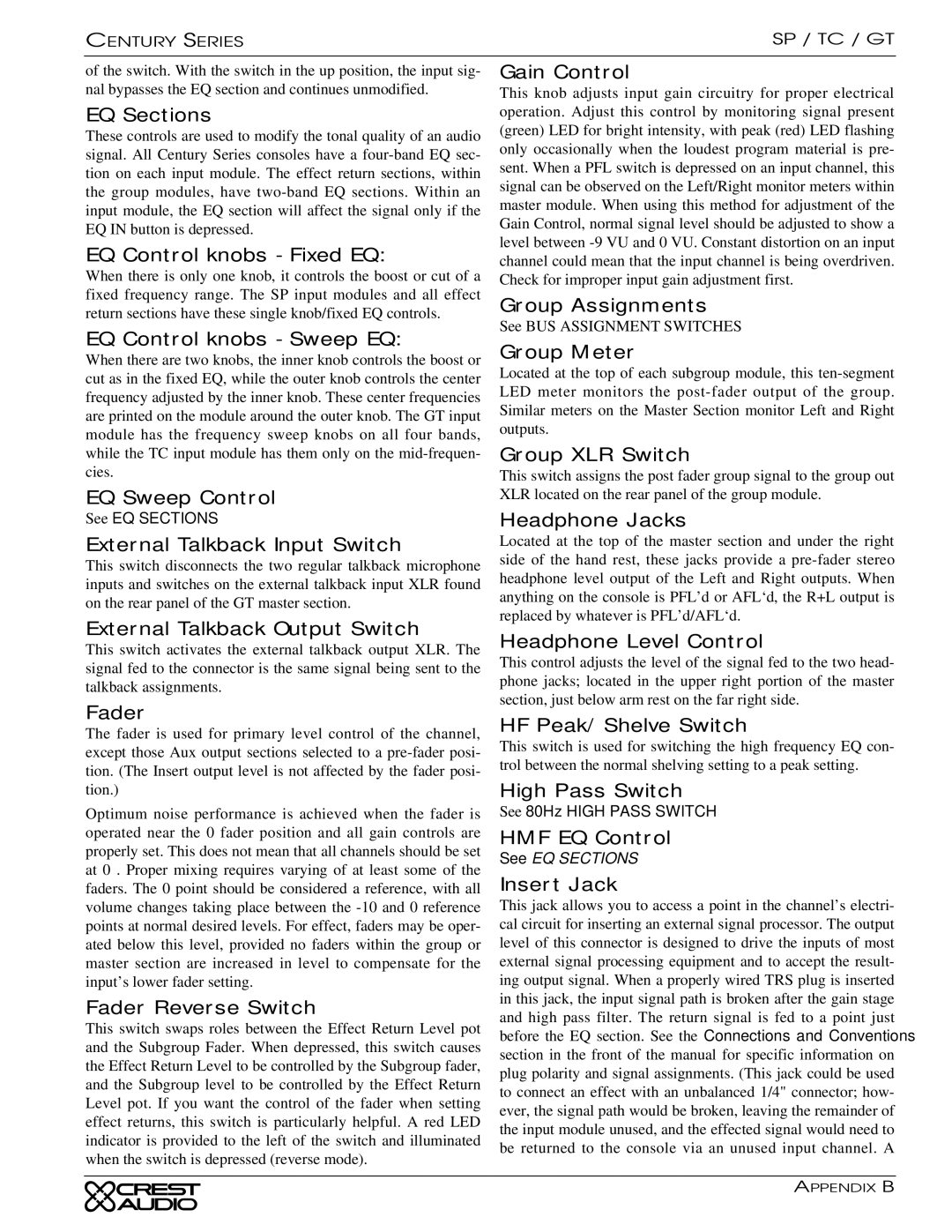CENTURY SERIES | SP / TC / GT |
of the switch. With the switch in the up position, the input sig- nal bypasses the EQ section and continues unmodified.
EQ Sections
These controls are used to modify the tonal quality of an audio signal. All Century Series consoles have a
EQ Control knobs - Fixed EQ:
When there is only one knob, it controls the boost or cut of a fixed frequency range. The SP input modules and all effect return sections have these single knob/fixed EQ controls.
EQ Control knobs - Sweep EQ:
When there are two knobs, the inner knob controls the boost or cut as in the fixed EQ, while the outer knob controls the center frequency adjusted by the inner knob. These center frequencies are printed on the module around the outer knob. The GT input module has the frequency sweep knobs on all four bands, while the TC input module has them only on the
EQ Sweep Control
See EQ SECTIONS
External Talkback Input Switch
This switch disconnects the two regular talkback microphone inputs and switches on the external talkback input XLR found on the rear panel of the GT master section.
External Talkback Output Switch
This switch activates the external talkback output XLR. The signal fed to the connector is the same signal being sent to the talkback assignments.
Fader
The fader is used for primary level control of the channel, except those Aux output sections selected to a
Optimum noise performance is achieved when the fader is operated near the 0 fader position and all gain controls are properly set. This does not mean that all channels should be set at 0 . Proper mixing requires varying of at least some of the faders. The 0 point should be considered a reference, with all volume changes taking place between the
Fader Reverse Switch
This switch swaps roles between the Effect Return Level pot and the Subgroup Fader. When depressed, this switch causes the Effect Return Level to be controlled by the Subgroup fader, and the Subgroup level to be controlled by the Effect Return Level pot. If you want the control of the fader when setting effect returns, this switch is particularly helpful. A red LED indicator is provided to the left of the switch and illuminated when the switch is depressed (reverse mode).
Gain Control
This knob adjusts input gain circuitry for proper electrical operation. Adjust this control by monitoring signal present (green) LED for bright intensity, with peak (red) LED flashing only occasionally when the loudest program material is pre- sent. When a PFL switch is depressed on an input channel, this signal can be observed on the Left/Right monitor meters within master module. When using this method for adjustment of the Gain Control, normal signal level should be adjusted to show a level between
Group Assignments
See BUS ASSIGNMENT SWITCHES
Group Meter
Located at the top of each subgroup module, this
Group XLR Switch
This switch assigns the post fader group signal to the group out XLR located on the rear panel of the group module.
Headphone Jacks
Located at the top of the master section and under the right side of the hand rest, these jacks provide a
Headphone Level Control
This control adjusts the level of the signal fed to the two head- phone jacks; located in the upper right portion of the master section, just below arm rest on the far right side.
HF Peak/Shelve Switch
This switch is used for switching the high frequency EQ con- trol between the normal shelving setting to a peak setting.
High Pass Switch
See 80Hz HIGH PASS SWITCH
HMF EQ Control
See EQ SECTIONS
Insert Jack
This jack allows you to access a point in the channel’s electri- cal circuit for inserting an external signal processor. The output level of this connector is designed to drive the inputs of most external signal processing equipment and to accept the result- ing output signal. When a properly wired TRS plug is inserted in this jack, the input signal path is broken after the gain stage and high pass filter. The return signal is fed to a point just before the EQ section. See the Connections and Conventions section in the front of the manual for specific information on plug polarity and signal assignments. (This jack could be used to connect an effect with an unbalanced 1/4" connector; how- ever, the signal path would be broken, leaving the remainder of the input module unused, and the effected signal would need to be returned to the console via an unused input channel. A
APPENDIX B
